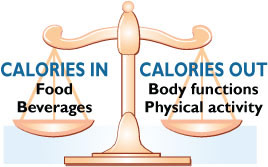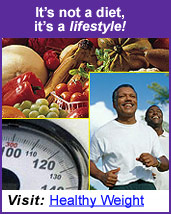Contributing Factors
Overweight and Obesity: An Overview
Is there a quick answer to the question, "what contributes to overweight and obesity?"
Overall there are a variety of factors that play a role in obesity. This makes it a complex health issue to address. This section will address how behavior, environment, and genetic factors may have an effect in causing people to be overweight and obese.
|
The Caloric Balance Equation
When it comes to maintaining a healthy weight for a lifetime, the bottom line is — calories count! Weight management is all about balance—balancing the number of calories you consume with the number of calories your body uses or "burns off."
- A calorie is defined as a unit of energy supplied by food. A calorie is a calorie regardless of its source. Whether you’re eating carbohydrates, fats, sugars, or proteins, all of them contain calories.
- Caloric balance is like a scale. To remain in balance and maintain your body weight, the calories consumed (from foods) must be balanced by the calories used (in normal body functions, daily activities, and exercise).

| If you are… | Your caloric balance status is …. |
|---|---|
| Maintaining your weight | "in balance." You are eating roughly the same number of calories that your body is using. Your weight will remain stable. |
| Gaining weight | "in caloric excess." You are eating more calories than your body is using. You will store these extra calories as fat and you’ll gain weight. |
| Losing weight | "in caloric deficit." You are eating fewer calories than you are using. Your body is pulling from its fat storage cells for energy, so your weight is decreasing. |
Genetics and the environment may increase the risk of personal weight gain. However, the choices a person makes in eating and physical activity also contributes to overweight and obesity.
For more, see Healthy Weight – Balancing Calories.
Environment
People may make decisions based on their environment or community. For example, a person may choose not to walk to the store or to work because of a lack of sidewalks. Communities, homes, and workplaces can all influence people's health decisions. Because of this influence, it is important to create environments in these locations that make it easier to engage in physical activity and to eat a healthy diet. The Surgeon General’s Call to Action to Prevent and Decrease Overweight and Obesity 2001 identified action steps for several locations that may help prevent and decrease obesity and overweight. The following table provides some examples of these steps.
| Location | Steps to Help Prevent and Decrease Overweight and Obesity |
|---|---|
| Home |
|
| Schools |
|
| Work |
|
| Community |
|
Genetics
How do genes affect obesity?
|
Science shows that genetics plays a role in obesity. Genes can directly
cause obesity in disorders such as Bardet-Biedl syndrome and Prader-Willi
syndrome.
However genes do not always predict future health. Genes and behavior may
both be needed for a person to be overweight. In some cases multiple genes
may increase one’s susceptibility for obesity and require outside
factors; such as abundant food supply or little physical activity.
For more information on the genetics and obesity visit
Obesity and Genetics: A Public Health Perspective.
Other Factors
Diseases and Drugs
Some illnesses may lead to obesity or weight gain. These may include
Cushing's disease, and polycystic ovary syndrome. Drugs such as steroids
and some antidepressants may also cause weight gain.
A doctor is the best source to tell you whether illnesses, medications, or
psychological factors are contributing to weight gain or making weight
loss hard.
Related Resources
Preventing
Pediatric Overweight and Obesity: AMERICAN ACADEMY OF PEDIATRICS Policy
Statement*
The dramatic increase in the prevalence of childhood overweight and its
health consequences are associated with significant health problems and
financial burdens. This statement proposes strategies
to foster prevention and early identification of overweight and obesity in
children, and for dietary and physical activity interventions during
physical check ups.
Understanding Adult Obesity
The National Institute of Health’s National Institute of Diabetes and
Digestive and Kidney Diseases (NIDDK) created a weight-control information
network. This site is an online resource for information on obesity, its
causes, and health risks, and provides measurement tools and relevant
publications on the topic.
![]() Please note: Some of these publications are available for download only as *.pdf files. These files require Adobe Acrobat Reader in order to be viewed. Please review the information on downloading and using Acrobat Reader software.
Please note: Some of these publications are available for download only as *.pdf files. These files require Adobe Acrobat Reader in order to be viewed. Please review the information on downloading and using Acrobat Reader software.
* Links to non-Federal organizations found at this site are provided solely as a service to our users. These links do not constitute an endorsement of these organizations or their programs by CDC or the Federal Government, and none should be inferred. CDC is not responsible for the content of the individual organization Web pages found at these links.
Page last updated: May 21, 2008
Content Source: Division of Nutrition, Physical Activity and Obesity, National Center for Chronic Disease Prevention and Health Promotion

